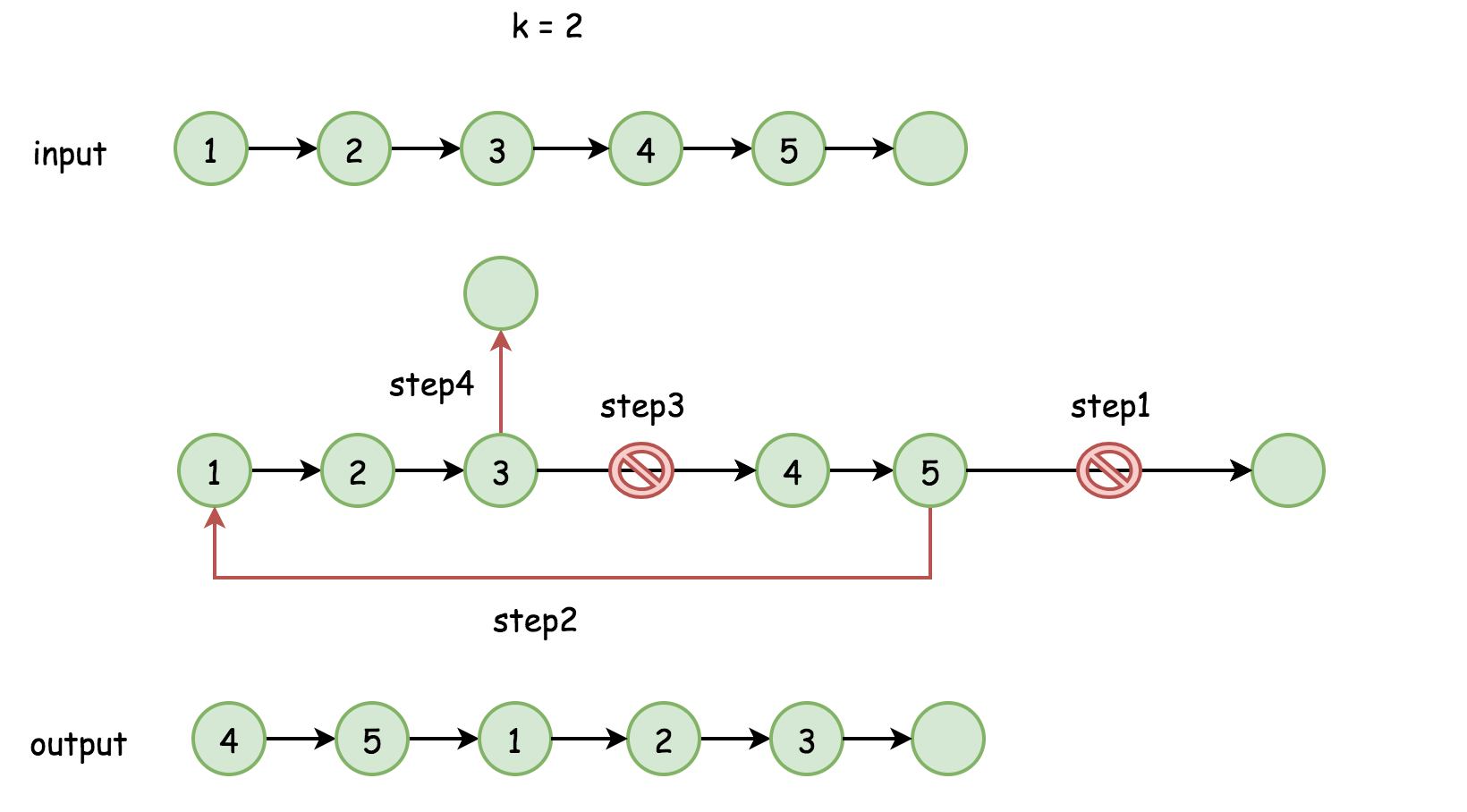给定一个链表,旋转链表,将链表每个节点向右移动 k 个位置,其中 k 是非负数。
示例 1:
输入: 1->2->3->4->5->NULL, k = 2
输出: 4->5->1->2->3->NULL
解释:
向右旋转 1 步: 5->1->2->3->4->NULL
向右旋转 2 步: 4->5->1->2->3->NULL
示例 2:
输入: 0->1->2->NULL, k = 4
输出: 2->0->1->NULL
解释:
向右旋转 1 步: 2->0->1->NULL
向右旋转 2 步: 1->2->0->NULL
向右旋转 3 步: 0->1->2->NULL
向右旋转 4 步: 2->0->1->NULL
思路一:思路与左旋转字符串类似,利用画图理解,并定义一个向右移动一位的函数rightMove,注意空指针的情形,然后注意k可能大于链表长度,所以这时候需要取一下余,不然会超时
思路二:不需要定义向右移动一位的函数,说是循环旋转,但其实本质上是将尾部向前数第K个元素作为头,原来的头接到原来的尾上。理解这句话:
- 先将链表闭合成环
- 找到相应的位置断开这个环,确定新的链表头和链表尾
O(n)
O(1)
C++:
/**
* Definition for singly-linked list.
* struct ListNode {
* int val;
* ListNode *next;
* ListNode(int x) : val(x), next(NULL) {}
* };
*/
class Solution {
public:
ListNode* rotateRight(ListNode* head, int k) {
if (head==NULL || k<=0)
return head;
ListNode* temp = head;
int n = 0;//链表长度
while(temp)
{
n++;
temp = temp->next;
}
ListNode* dummyhead = new ListNode(-1);
temp = head;
k = k%n;
for (int i=0;i<k;i++)
{
temp = rightMove(temp);
}
dummyhead->next = temp;
return dummyhead->next;
}
ListNode* rightMove(ListNode* head)
{
if (head==NULL || head->next==NULL)
return head;
ListNode* prev = NULL;
ListNode* cur = head;
ListNode* temp = head;
while(cur->next!=NULL)
{
prev = cur;
cur = cur->next;
}
prev->next = cur->next;
cur->next = temp;
return cur;
}
};/**
* Definition for singly-linked list.
* struct ListNode {
* int val;
* ListNode *next;
* ListNode(int x) : val(x), next(NULL) {}
* };
*/
class Solution {
public:
ListNode* rotateRight(ListNode* head, int k) {
if (head==NULL || k<=0)
return head;
ListNode* cur = head;
ListNode* tail = NULL;
int n = 0;
while(cur)
{
n++;
tail = cur; // 循环结束后指向尾节点
cur = cur->next;
}
k = k%n; // 改为小于n的数,注意是从后往前数,所以后边循环要改成n-k
tail->next = head; // 尾节点又指向头节点,形成一个环
cur = head; // 从头开始循环
for (int i=0;i<n-k-1;i++) // 到正数k-1个节点
{
cur = cur->next;
}
head = cur->next;
cur->next = NULL;
return head;
}
};# Definition for singly-linked list.
# class ListNode:
# def __init__(self, x):
# self.val = x
# self.next = None
class Solution:
def rotateRight(self, head: ListNode, k: int) -> ListNode:
if head==None or k<=0:
return head
temp = head
n = 0
while temp:
n+=1
temp = temp.next
k = k%n
temp = head
for i in range(k):
temp = self.rightMove(temp)
return temp
def rightMove(self,head):
if head==None or head.next==None:
return head
prev = None
cur = head
temp = head
while cur.next:
prev = cur
cur = cur.next
prev.next = cur.next
cur.next = temp
return cur# Definition for singly-linked list.
# class ListNode:
# def __init__(self, x):
# self.val = x
# self.next = None
class Solution:
def rotateRight(self, head: ListNode, k: int) -> ListNode:
if head==None or k<=0:
return head
cur = head
tail = None
n = 0
while cur:
n+=1
tail = cur
cur = cur.next
k = k%n
tail.next = head
cur = head
for i in range(n-k-1):
cur = cur.next
head = cur.next
cur.next = None
return head